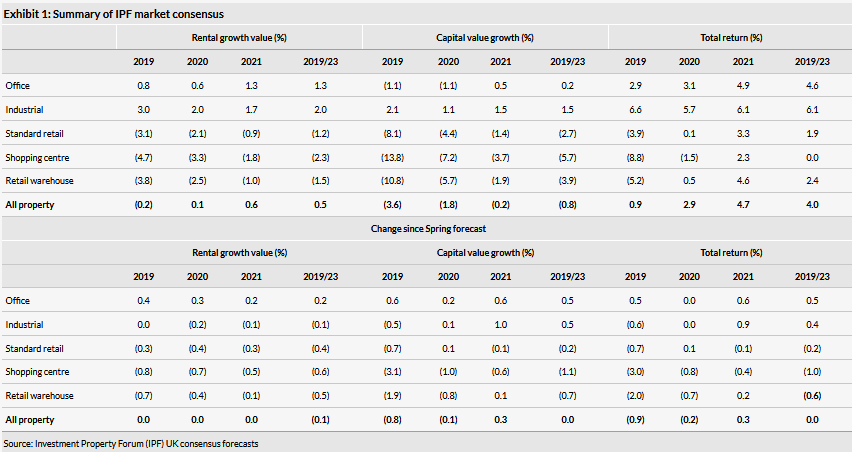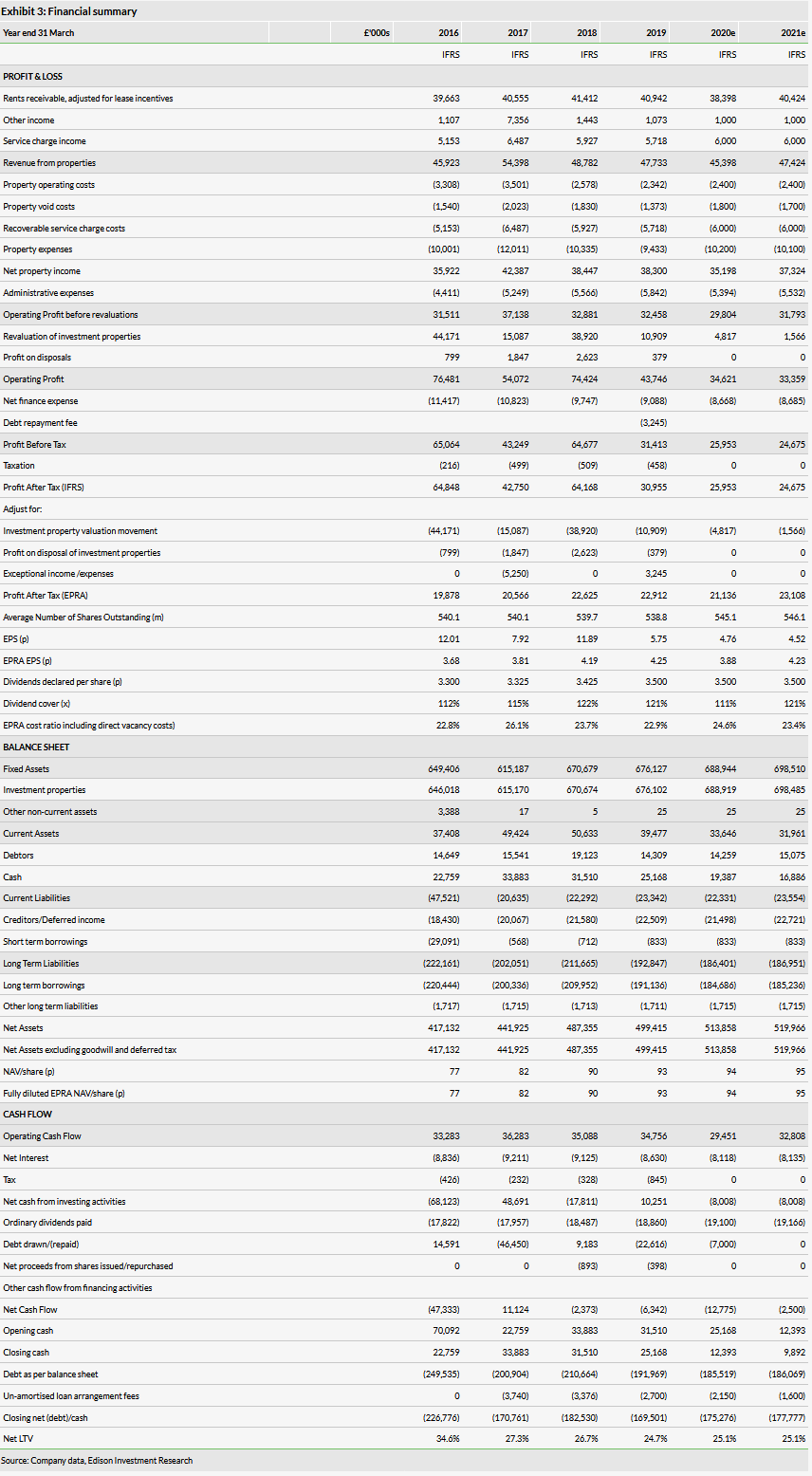
In its recent portfolio update, Picton Property Income Ltd (LON:PCTN) provided details of significant activity and progress across all property sectors, since its June NAV announcement. This is particularly encouraging given the traditionally quiet summer period and the uncertain political backdrop. The June NAV update showed continuing positive returns, benefiting from an overweight position in industrial and office assets, and the portfolio update shows progress towards unlocking reversionary potential from the portfolio.
Unlocking potential
Since the June NAV update, a total of 20 asset management initiatives with a combined annual rent of £2.4m have been completed, including new lettings, lease renewals, re-gears and rent reviews. These were agreed at rent levels that on average were 4% ahead of the estimated rental values (ERVs) at 30 June 2019. Picton is also continuing to invest in portfolio and unlock future opportunities to improve occupancy and rental income, deploying proceeds from the June share placing. Two of the more than 20 identified refurbishment projects have been completed, with occupiers identified and terms agreed in principle.
Reversionary potential supports growth prospects
Portfolio performance continues to benefit from an overweight position in industrial and regional office property, where returns have been positive, supported by a positive market supply-demand balance, and a significant underweighting of retail and leisure (with no shopping centre exposure), where rents and capital values remain under pressure. Growth prospects further benefit from the significant reversionary potential (end-FY19 estimated market rents c 24% above passing rents) and clearly identified asset management initiatives. Our forecasts for income earnings and DPS are unchanged. With increased economic and market uncertainties, capital values are more difficult to call across the wider UK real estate market and, reflecting this, we have slightly reduced our capital growth assumptions and forecast NAV.
Valuation: Total return with sustainable income focus
Picton offers a current yield of 4.0% and trades at a small discount to its last-reported NAV. Although it has a strong income focus, its dividend yield is lower than the peer average, reflecting a fully covered position that provides scope to reinvest in the portfolio in ways designed to support occupancy and income growth, with the specific goal of enhancing long-term total return.
Business description
Picton Property Income is an internally managed UK REIT that invests in a diversified portfolio of commercial property across the UK. It is total return driven with an income focus and aims to generate attractive returns through proactive management of the portfolio.
Unlocking potential in the existing portfolio
Picton’s property portfolio performance continues to benefit from its sector positioning, while significant reversionary potential and identified asset management initiatives within the existing portfolio provide the opportunity for continued growth and value creation
Asset management delivering rental growth
A total of 20 asset management initiatives with a combined annual rent of £2.4m have been completed, including new lettings, lease renewals, re-gears and rent reviews. These were agreed at rent levels that on average were 4% ahead of the ERVs at 30 June 2019.
At the end of FY19 (the last available data) the portfolio ERV of £46.8m was £9.1m (or 24%) ahead of passing rent, representing a significant opportunity to grow income through asset management initiatives even if market conditions weaken. The reversionary potential was spread across the portfolio (industrial: £2.7m; office: £3.9m; retail: £2.5m) and more than half related to void reduction. EPRA occupancy of 90% at end FY19 (and a similar level at end Q120) was somewhat below the c 95% of the previous four years. The reduction reflected a bunching of lease expiries towards the end of FY19, as well as management’s decision to surrender a number of leases to facilitate active asset management of the assets and drive future income and value growth. The majority of the upside from void reduction was within the office portfolio (£2.9m), with the retail sector accounting for much of the rest (£1.5m). With industrial sector occupancy already at a high level, the upside from void reduction was much lower (£0.4m).
Progress with asset management projects
The company has also made progress with the deployment of the £7.0m (net of costs) proceeds from its June share placing, having completed two refurbishment projects, where occupiers have been identified and terms agreed in principle. These projects are among more than 20 identified asset management initiatives in the portfolio, representing an aggregate investment of c £15m, which we expect to be spread over the next couple of years. These initiatives are aimed at improving the quality of the existing portfolio assets with the intention of delivering higher occupancy, rental income and capital values, and include:
upgrading and repositioning of internal space;
converting assets to higher-value uses; and
enhancing the external fabric to help retain existing or attract new occupiers.
Industrial and office assets continue to drive portfolio returns
Amidst some slowing of UK economic growth and continuing Brexit-related uncertainty, the UK commercial property market has entered a period of increased uncertainty with sector performance becoming increasingly polarised. The industrial sector has continued to show the strongest returns whereas the retail sector has suffered a marked deterioration as retailers struggle with rising labour costs and business rates and, in many cases, the impact of online competition.
Picton’s investment strategy targets a diversified portfolio, but with an unconstrained approach to portfolio construction that adapts the sector and asset weighting to changing market conditions. Compared with the MSCI Quarterly Property Index, the portfolio has around double the weighting to the industrial sector (with a high south-east share) and around half the weighting in retail/leisure sectors (no exposure to shopping centres). The regional (rather than central London) nature of Picton’s office exposure has also contributed positively to performance.

Looking forward, the most recent quarterly market forecasts by the Investment Property Forum (IPF, canvassing a group of fund managers and surveyors under the IPF Research Programme) were published in September and point to a deterioration in expectations for capital growth over the past quarter. This is focused on the retail sector, where the expectation of capital value decline has increased but also includes industrial, where expectations of capital value growth have been tempered. The consensus expectation for overall total property return remains positive despite weakness in retail.
We present the market consensus data as a guide to expected overall market direction and returns but would caution against a direct read across to Picton’s, or any other, portfolio. The market consensus is formed of a wide range of differing expectations and at the individual portfolio level much depends on the performance of individual assets as well as the timing and effectiveness of asset management initiatives. In the three months to 30 June 2019 (Q120), Picton reported a 0.5% weighted average increase in portfolio valuation, driven by industrial (+2.3%) and offices (+0.3%), partly offset by retail & leisure (-3.4%). However, as we discuss in the next section, we have slightly trimmed our forecasts for Picton’s capital growth in recognition of market-wide trends.
Forecast update
Our income forecasts can be seen in detail in our outlook note published on 29 July and we make no changes to these. These assume an unchanged portfolio, although Picton continues to explore new investment opportunities, and is likely to continue to divest of mature assets and take the opportunity to actively manage sector positioning. For the portfolio as a whole, we forecast growth in rent roll from £37.7m at end-FY19 to £39.5m at end-FY20 and £40.9m at end-FY21, resulting from rental growth and occupancy improvement. These forecasts may prove conservative given the significant upside to ERV (£46.8m at end-FY19) that will remain. We expect ERV to increase slightly over the next two years as growth in industrial and office asset ERVs outstrips weakness in retail and leisure. Asset management projects will temporarily reduce FY20 rental income and EPRA earnings, but as these complete we expect growth to resume in FY21. Distribution policy makes allowance for portfolio investment and, from a high cover ratio of c 1.2x in FY19, we see cover of the 3.5p per share annualised dividend payout being maintained at a good level (c 1.1x) in FY20 and increasing in FY21 (c 1.2x). The FY21 level of cover may indicate scope for a resumption of dividend growth.
While leaving our income forecasts unchanged, we have slightly reduced our expectations for capital growth. We had previously assumed property asset valuation growth in line with the blended rate of like-for-like rental growth (c 1% in FY20 and FY21), implicitly assuming continuing growth in industrial valuations and, to a lesser extent, in office valuations, with a further decline in retail and leisure valuations. Our revised forecasts remain directionally the same, although we have moderated our assumption for industrial and office capital growth and now expect retail values to decline further in FY21 rather than stabilising. The blended rate of capital growth is now assumed to be 0.7% in FY20 and 0.2% in FY21. Given our rental growth expectations, this implies an increase in net initial yield (NIY) from c 4.9% at end FY19 to c 5.2% at end FY21.

